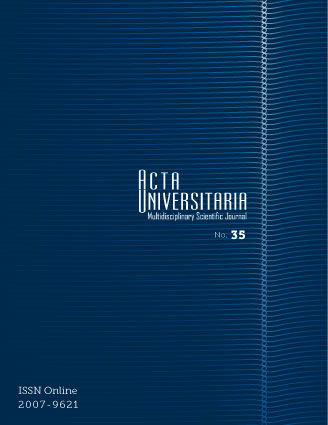Análisis petrofísico de los pozos SM perforados en el acuífero granular de la parte central de la Cuenca Alta del Río Laja, Guanajuato, México
Published 2025-07-30
How to Cite
Abstract
Well logs from the SM-1 and SM-2 groundwater wells were analyzed using spontaneous potential, natural gamma ray, resistivity, and temperature logs. The petrophysical analysis allowed the identification of porous, permeable, and less consolidated beds named here as “Arenas I, II, III, III´, IV, V”, as well as two intercalation intervals where sands alternate with more compact layers, marked as “Intercalación I and II”. The X-ray diffraction analysis in SM-2 well reports sanidine; the occurrence of this potassium feldspar interferes with using the natural gamma ray log as a shale indicator. The well log correlation between SM-1 and SM-2 is congruent. It is recommended to add more logs in future wells in order to improve the interpretation, and quantify formation parameters such as porosity and hydraulic conductivity.
References
- Alaniz-Álvarez, S. A., Nieto-Samaniego, A. F., Orozco-Esquivel, M. T., Vasallo, L. F., & Xu, S. (2002). El sistema de fallas Taxco-San Miguel de Allende: Implicaciones de la deformación post-eocénica del centro de México. Boletín de la Sociedad Geológica Mexicana, 55(1), 12-29. https://www.jstor.org/stable/24920368
- Alaniz-Álvarez, S. A., Nieto-Samaniego, A. F., Reyes-Zaragoza, M. A., Orozco-Esquivel, M. T., Ojeda-García, A. C., & Vassallo, L. F. (2001). Estratigrafía y deformación extensional en la región San Miguel de Allende-Querétaro, México. Revista Mexicana de Ciencias Geológicas, 18(2), 129–148. https://www.rmcg.unam.mx/index.php/rmcg/article/view/990
- Alaniz-Álvarez, S. A., & Nieto-Samaniego, Á. F. (2005). El sistema de fallas Taxco-San Miguel de Allende y la Faja Volcánica Transmexicana, dos fronteras tectónicas del centro de México activas durante el Cenozoico. Boletín de la Sociedad Geológica Mexicana, 57(1), 65-82. https://doi.org/10.18268/bsgm2005v57n1a4
- Cid-Villegas, G., Alaniz-Álvarez, S. A., Xu, S., Vázquez-Serrano, A., & Juárez-Arriaga, E. (2022). Deformación del Cretácico tardío en el límite de la Mesa Central y la Sierra Madre Oriental, centro de México. Boletín de la Sociedad Geológica Mexicana, 74(2), 1-31. https://doi.org/10.18268/bsgm2022v74n2a230222
- Comisión Nacional del Agua (Conagua). (2024). Actualización de la disponibilidad media anual de agua en el acuífero Cuenca Alta del Río Laja (1108) Estado de Guanajuato. https://sigagis.conagua.gob.mx/gas1/Edos_Acuiferos_18/guanajuato/DR_1108.pdf
- Del Pilar-Martínez, A., Nieto-Samaniego, A. F., & Alaniz-Álvarez, S. A. (2020). Development of a brittle triaxial deformation zone in the upper crust: the case of the Southern Mesa Central of Mexico. Tectonics, 39(11), e2020TC006166. https://doi.org/10.1029/2020TC006166
- Ellis, D. V., & Singer, J. M. (2008). Well Logging for Earth Scientists. Springer.
- Fitz-Díaz, E., Lawton, T. F., Juárez-Arriaga, E., & Chávez-Cabello, G. (2018). The Cretaceous-Paleogene Mexican orogen: structure, basin development, magmatism and tectonics. Earth-Science Reviews, 183, 56-84. https://doi.org/10.1016/j.earscirev.2017.03.002
- Flóvenz, Ó. G, Hersir, G. P., Sæmundsson, K., Ármannsson, H., & Friðriksson, Þ. (2012). Geothermal energy exploration techniques. Comprehensive Renewable Energy, 7, 51–95. https://doi.org/10.1016/B978-0-08-087872-0.00705-8
- Gómez-Tuena, A., Orozco-Esquivel, M. T., & Ferrari, L. (2005). Petrogénesis ígnea de la Faja Volcánica Transmexicana. Boletín de la Sociedad Geológica Mexicana, 57(3), 227-283. https://doi.org/10.18268/bsgm2005v57n3a2
- Instituto Nacional de Estadística y Geografía (INEGI). (2001). Conjunto de datos vectoriales fisiográficos. Escala 1:1 000 000. Serie I. https://datos.gob.mx/busca/dataset/conjunto-de-datos-vectoriales-fisiograficos-continuo-nacional-escala-1-1-000-000-serie-i/resource/c6dcd12c-0c2a-4db7-a769-bcbb338b1cbe
- Instituto Nacional de Estadística y Geografía (INEGI). (2019). Conjunto de datos aguas subterráneas. Zona Hidrogeológica Alto Río Laja Serie II, Escala 1:250 000. https://www.inegi.org.mx/app/biblioteca/ficha.html?upc=889463769200
- Mahlknecht, J., Schneider, J. F., Merkel, B. J., Navarro-de-León, I., & Bernasconi, S. M. (2004). Groundwater recharge in a sedimentary basin in semi-arid Mexico. Hydrogeology Journal, 12, 511-530. https://doi.org/10.1007/s10040-004-0332-6
- Martini, M., Solari, L., & Camprubí, A. (2013). Kinematics of the Guerrero terrane accretion in the Sierra de Guanajuato, central Mexico: new insights for the structural evolution arc-continent collisional zones. International Geology Review, 55(5), 574-589. http://dx.doi.org/10.1080/00206814.2012.729361
- Martini, M., Solari, L., & López-Martínez, M. (2014). Correlating the Arperos Basin from Guanajuato, central Mexico, to Santo Tomás, southern Mexico: Implications for the paleogeography and origin of the Guerrero terrane. Geosphere, 10(6), 1385-1401. https://doi.org/10.1130/GES01055.1
- Martini, M., Solé, J., Garduño-Martínez, D. E., Pi-Puig, T., & Omaña, L. (2016). Evidence for two Cretaceous superposed orogenic belts in central Mexico based on paleontologic and K-Ar geochronologic data from the Sierra de los Cuarzos. Geosphere, 12(4), 1–14. https://doi.org/10.1130/GES01275.1
- Nieto-Samaniego, Á. F., Alaniz-Álvarez, S. A., & Camprubí, A. (2005). La Mesa Central de México: estratigrafía, estructura y evolución tectónica cenozoica. Boletín de la Sociedad Geológica Mexicana, 57(3), 285-318. https://doi.org/10.18268/bsgm2005v57n3a3
- Nieto-Samaniego, Á. F., Ferrari, L., Alaniz-Alvarez, S. A., Labarthe-Hernández, G., & Rosas-Elguera, J. (1999). Variations of Cenozoic extension and volcanism across the southern Sierra Madre Occidental volcanic province, Mexico. GSA Bulletin, 111(3), 347-363. https://doi.org/10.1130/0016-7606(1999)111<0347:VOCEAV>2.3.CO;2
- Olmos-Moya, M. J. P. (2018). Exhumación de los intrusivos Comanja y Tesorera: Implicaciones en el levantamiento de la Mesa Central de México [Tesis de Maestría]. Universidad Nacional Autónoma de México.
- Ortega-Flores, B., Solari, L., Lawton, T. F., & Ortega-Obregón, C. (2014). Detrital-zircon record of major Middle Triassic-Early Cretaceous provenance shift, central Mexico: demise of Gondwanan continental fluvial systems and onset of back-arc volcanism and sedimentation. International Geology Review, 56(2), 237-261. https://doi.org/10.1080/00206814.2013.844313
- Ortega-Guerrero, M. A. (2009). Presencia, distribución, hidrogeoquímica y origen de arsénico, fluoruro y otros elementos traza disueltos en agua subterránea, a escala de cuenca hidrológica tributaria de Lerma-Chapala, México. Revista Mexicana de Ciencias Geológicas, 26(1), 143-161. https://www.scielo.org.mx/scielo.php?pid=s1026-87742009000100012&script=sci_arttext
- Ortiz-Hernández, L. E., Chiodi, M., Lapierre, H., Monod, O., & Calvet, P. (1990). El arco intraoceánico alóctono (Cretácico Inferior) de Guanajuato–Características petrográficas, geoquímicas, estructurales e isotópicas del complejo filoniano y de las lavas basálticas asociadas--implicaciones geodinámicas. Revista Mexicana de Ciencias Geológicas, 9(2), 125-145. http://rmcg.geociencias.unam.mx/index.php/rmcg/article/view/1221
- Schlumberger (1998). Log Interpretation Principles/Applications (7ma. ed.). Schlumberger Wireline & Testing, Sugar Land, Texas.
- Servicio Geológico Mexicano (SGM). (1997). Carta geológica-minera Guanajuato F14-7, escala 1:250 000. https://mapserver.sgm.gob.mx/Cartas_Online/geologia/76_F14-7_GM.pdf
- Servicio Geológico Mexicano (SGM). (1999). Carta geológica-minera Querétaro F14-10, escala 1:250 000. https://mapserver.sgm.gob.mx/Cartas_Online/geologia/77_F14-10_GM.pdf

